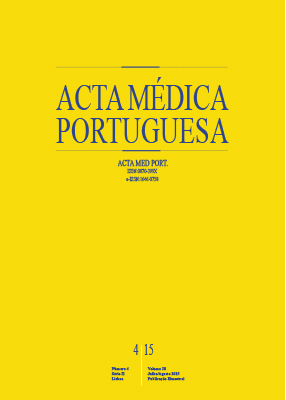The Impact of Cochlear Implant in the Oral Language of Children with
DOI:
https://doi.org/10.20344/amp.5997Keywords:
Child, Cochlear Implants, Hearing Loss, Sensorineural, Language Development, Speech Acoustics, Speech Perception.Abstract
Introduction: Children with severe to profound sensorineural deafness can acquire vocabulary and syntactic structures to communicate by oral language, after cochlear implant.Aim: Identify the linguistic skills of children with cochlear implant.
Material and Methods: Eighteen children of both gender, between 9 and 10 years, with congenital bilateral deafness, using cochlear implant, were studied. The evaluation instrument used was Observation Chart of Language-School Level. The results were compared with standard of normal-hearing children with the same hearing age.
Results: The scores registered in the linguistics structures studied, comparing implanted children and standard, was: phonology, 29.44 ± 8.4 vs. 29.68 ± 5.90, p = 0.91; semantics, 18.55 ± 8.89 vs. 19.20 ± 4.85, p = 0.76; morpho-syntax 21.89 ± 12.85 vs. 26.35 ± 10.36, p = 0.159. Regarding the tests of semantics, there was no significant difference. Concerning the tests of morpho-syntactic structure, the
difference was significant in the derivation of words, 2.83 ± 2.81 vs. 4.65 ± 1.64, p = 0.014. In the phonology, a significant difference was found comparing implanted children and standard, in the discrimination of pseudo words, 6.6 ± 2.8 vs. 8.37 ± 2.32, p = 0.023. However, in syllabic segmentation, implanted children had a mean score 8.56 ± 1.6 significantly higher than standard, 5.9 ± 1.58, p < 0.001.
Discussion: The similarity of the scores obtained by children with cochlear implants with the standard, in the language components studied confirms that cochlear implant promotes the development of oral verbal language in children with congenital deafness.
Conclusions: Implanted children had acquired language skills similar to normal-hearing children with the same hearing age.
Downloads
Downloads
Published
How to Cite
Issue
Section
License
All the articles published in the AMP are open access and comply with the requirements of funding agencies or academic institutions. The AMP is governed by the terms of the Creative Commons ‘Attribution – Non-Commercial Use - (CC-BY-NC)’ license, regarding the use by third parties.
It is the author’s responsibility to obtain approval for the reproduction of figures, tables, etc. from other publications.
Upon acceptance of an article for publication, the authors will be asked to complete the ICMJE “Copyright Liability and Copyright Sharing Statement “(http://www.actamedicaportuguesa.com/info/AMP-NormasPublicacao.pdf) and the “Declaration of Potential Conflicts of Interest” (http:// www.icmje.org/conflicts-of-interest). An e-mail will be sent to the corresponding author to acknowledge receipt of the manuscript.
After publication, the authors are authorised to make their articles available in repositories of their institutions of origin, as long as they always mention where they were published and according to the Creative Commons license.









